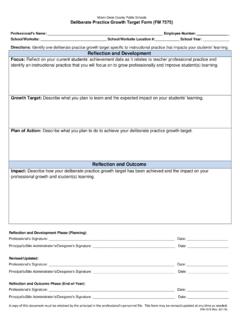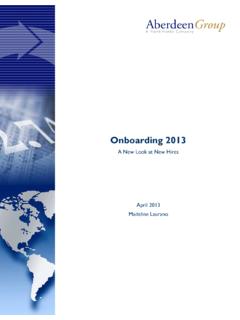Transcription of Deliberate Practice Growth Target - citrusgrovems.org
1 Deliberate Practice Growth Target Mr. Cubillas Mrs. Pino Three Components of IPEGS. The IPEGS Unified Summative Rating breakdown is as follows: Learner Progress (35%). Professional practices (50%). DPGT (15%). Legend for IPEGS Performance Standards: Teachers: Student Learning Measures Observable Standards Non-Observable Performance Standard 1. Learners Progress 5. Assessment 2. Knowledge of 6. Communication Learners 3. Instructional Planning 7. Professionalism 4. Instructional Delivery 8. Learning and Engagement Environment Instructional Support Legend for IPEGS Performance Standards: and Student Services Student Learning Measures Observable Standards Professional Non-Observable Performance Standard 1. Learner/Program 5. Assessment Progress 2. Knowledge of 6. Communication Learners 3. Program 7. Professionalism Management 4. Program Delivery PS 2: Knowledge of Learners The teacher identifies and addresses the needs of learners by demonstrating respect for individual differences, cultures, backgrounds, and learning styles.
2 The professional: Responds to the intellectual, social, and physical development of the age group Presents concepts at different levels of complexity for students of varying developmental stages Provides a range of activities: readiness, interests, learning styles, and cultural/linguistic backgrounds PS 3: Instructional Planning The teacher uses appropriate curricula, instructional strategies, and resources to develop lesson plans that include goals and/or objectives, learning activities, assessment of student learning, and home learning in order to address the diverse needs of students. The professional: Uses both formative and summative student learning data to guide planning Develops plans that are clear, logical, sequential, and aligned to standards - based learning Plans instruction effectively for content mastery, pacing, and transitions Identifies and plans for the instructional and developmental needs of all learners Gathers, evaluates, and/or creates appropriate instructional materials PS 4: Instructional Delivery and Engagement The teacher promotes learning by demonstrating accurate content knowledge and by addressing academic needs through a variety of appropriate instructional strategies and technologies that engage learners.
3 The professional: Engages students in diverse activity structures: individual, collaborative, and whole group Demonstrates current knowledge of content and standards Explains directions, concepts, and content in a logical and sequential manner Uses multiple levels of questions and makes adjustments for re- teaching/remediation/enrichment Connects students' prior knowledge, life experiences, and interests to learning goals PS 4: Instructional Delivery and Engagement (Continued). The professional: Presents lessons with use of explicit instruction Uses appropriate literacy strategies to build academic vocabulary Uses a variety of strategies to engage students in higher-order learning tasks Engages students in authentic learning, real-life applications, and interdisciplinary connections Uses appropriate pace and maximizes instructional time for student learning Uses technology to individualize instruction and enhance learning, as appropriate Reinforces learning goals throughout the lesson Provides ongoing, timely, and specific feedback to students PS 5: Assessment The teacher gathers, analyzes, and uses data (including state assessment data, as applicable) to measure learner progress, guide instruction, and provide timely feedback.
4 The professional: Uses local and state assessment data to design instruction that meets students'. needs Uses pre-assessment data, formative and summative assessments to inform instruction Uses formative assessments to adjust instruction for re-teaching, remediation, and enrichment Helps students understand assessment criteria, monitor, and reflect on their work Maintains sufficient assessment data to support accurate reporting of student progress Aligns assessments to learning goals and standards Provides timely and specific feedback to students, parents, and stakeholders PS 6: Communication The teacher communicates effectively with students, their parents or families, staff and other members of the learning community. The professional: Uses correct and acceptable forms of communication Communicates with colleagues from content areas/agencies to integrate instruction and/or services Maintains positive collaborative relationships with school personnel, families, and community stakeholders Uses technology to support and enhance communication, as appropriate Supports, promotes, and communicates the mission, vision, and goals of the school and M-DCPS.
5 PS 7: Professionalism The teacher demonstrates behavior consistent with legal, ethical, and professional standards and engages in continuous professional Growth . The professional: Follows all legal and procedural requirements: Code of Ethics, State Statutes, and Board Policies Reflects on strengths and areas for Growth and sets Deliberate Practice Growth targets for improvement Engages in ongoing and collaborative professional development Provides evidence of professional Growth experiences Incorporates learning from professional Growth opportunities and reflects upon effectiveness Contributes professionally to the school community Maintains accurate records ( , attendance records, IEPs). Works in a collegial and collaborative manner with school personnel and the community PS 8: Learning Environment The teacher creates and maintains a safe learning environment while encouraging fairness, respect, and enthusiasm. The professional: Establishes and maintains effective classroom rules and procedures Creates an environment that is stimulating, challenging, and fosters intellectual risk-taking Organizes a safe physical environment that is conducive to student learning and collaborative work Maintains an environment that reflects a culture of inclusivity, equity, and respect Promotes accountability for learning and holds high academic expectations for all students Uses verbal, nonverbal, and electronic communication tools to challenge and support students Encourages students to receive and accept constructive feedback on individual work and behavior DPGT Process Reflection and Development Phase Step 1: Data Collection Collect information regarding individual student learning.
6 What sources of information can you use to identify areas for professional Growth as it relates to student learning? Data Collection Examples CELLA Assessment IPEGS Rating PE/Fitness Assessment School Improvement Plan Learning Styles Inventory EOC Exams FSA/Interim Scores IEP's DPGT Process Reflection and Development Phase Step 2: Needs Assessment/Focus Based on the identified student needs, reflect and specify the training objectives expected to impact student performance. What areas of improvement might be your primary focus? Step 2: Needs Assessment/Focus Examples Sample Objectives To improve English/Language Arts (ELA) teaching methods To create a template that will assist students in planning for educational and vocational choices To provide more Inquiry-Based strategies (hands-on science activities). To incorporate authentic mathematical problems during instruction DPGT Process Reflection and Development Phase Step 3: Growth Target Determine a Deliberate Growth Target that addresses student learning.
7 Based on your focus, think about the Growth Target as it impacts student learning. Example of a Deliberate Practice Growth Target : During the school year, I will attend professional development to learn about the new ELA Florida Standards. This will impact my students' learning because they will be successful on the FSA. Reflection and Development Phase Step 4: Plan of Action Describe the specific professional development (PD)/professional Growth experience(s) that will allow you to achieve your Deliberate Practice Growth Target . Example of Plan of Action: I plan to attend Creating Independence through Student owned Strategies (CRISS) Training as well as state and district professional development on the Florida Standards and FSA. Reflection and Development Phase Step 5: DPGT Form Meet with administrator to review and sign the DPGT form. Professional's Signature:_____ Date _____. Site Administrator's Signature:_____ Date _____. Note: The DPGT form may be revised at any time as needed.
8 Reflection and Outcome Phase Step 6: Impact Describe how your professional Growth Target has been achieved and the impact on your professional Growth and student (s) learning. How do you know that you met your goal? What is your evidence? Example of Impact: As a result of participating in the CRISS Training and implementing the Question Answer Relationship (QAR) strategy with my students, their close reading skills improved as evidenced by improved scores on the district Interim Assessment and teacher created assignments. Reflection and Outcome Phase Step 7: Completion of DPGT Process Complete the DPGT form. Note: The completed form will be reviewed and signed by the professional and the site administrator. The completed and signed form must be included in the end-of-year documentation submitted by the professional.





